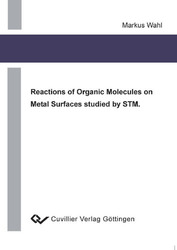| Departments | |
|---|---|
| Book Series (96) |
1377
|
| Nachhaltigkeit |
3
|
| Gesundheitswesen |
1
|
| Humanities |
2361
|
| Natural Sciences |
5403
|
| Mathematics | 229 |
| Informatics | 318 |
| Physics | 979 |
| Chemistry | 1362 |
| Geosciences | 131 |
| Human medicine | 243 |
| Stomatology | 10 |
| Veterinary medicine | 108 |
| Pharmacy | 147 |
| Biology | 835 |
| Biochemistry, molecular biology, gene technology | 121 |
| Biophysics | 25 |
| Domestic and nutritional science | 45 |
| Agricultural science | 1004 |
| Forest science | 201 |
| Horticultural science | 20 |
| Environmental research, ecology and landscape conservation | 148 |
| Engineering |
1788
|
| Common |
97
|
|
Leitlinien Unfallchirurgie
5. Auflage bestellen |
|
Advanced Search
Reactions of Organic Molecules on Metal Surfaces studied by STM. (English shop)
Markus Wahl (Author)Preview
Table of Contents, Datei (38 KB)
Extract, Datei (280 KB)
Two distinct systems of surface reactions involving complex organic molecules were studied on single crystal metal surfaces by Scanning Tunneling Microscopy (STM), Low Energy Electron Diffraction (LEED) and X-ray Photoelectron Spectroscopy (XPS) under ultra high vacuum conditions.
The first system focused on the Pt-cinchona alkaloid system, which is a powerful catalytic system in the field of enantioselective heterogeneous catalysis. Herein, an achiral reactant molecule is hydrogenated over a cinchona alkaloid modified platinum surface. The aim of the STM study was to gain direct insight in the molecular processes which occur during adsorption of modifiers and reactants involved. Therefore, the adsorption of cinchonidine (CD), cinchonine (CN) and 2,2,2-trifluoroacetophenone (TFAP) was investigated on both Pt(111) and Pd(111) single crystal surfaces. Different adsorption modes could be identified and a change in adsorption geometry upon addition of hydrogen could be followed. Our work showed, that the discrimination of different surface species by their mobility and the time-resolved observation of their surface chemical processes by STM provides a powerful tool for the investigation of complex catalyst systems. Such studies complement other surface analytical methods and quantum chemical calculations and help to gain insight into the mechanistic aspects.
The second system is an example of how surface reactions can be used to efficiently self-assemble large complex structures. For this purpose a perylene derivative, 4,9-diaminoperylene-quinone-3,10-diimine (DPDI), was deposited on a Cu(111) single crystal surface and investigated by STM. These highly mobile precursor molecules are then transformed via a thermally induced surface-assisted dehydrogenation reaction by annealing in-situ at 300 °C. The resulting molecules form autocomplementary species of hydrogen-bond donor and acceptors and thereby can interact with each other via H-bonding. Due to strong so-called resonance-assisted hydrogen-bondings (RAHB) and an exact register with the Cu surface a highly robust and porous hexagonal network structure is formed. This structure is well-suited for the incorporation or trapping of guest molecules. By trapping and manipulation of C60 and octaethylporphyrin (OEP) molecules inside this network it was possible to built exemplary nanosized supramolecular “ball-bearings” and “rotor-stator” systems.
| ISBN-13 (Printausgabe) | 3867271399 |
| ISBN-13 (Hard Copy) | 9783867271394 |
| ISBN-13 (eBook) | 9783736921399 |
| Final Book Format | A5 |
| Language | English |
| Page Number | 104 |
| Edition | 1 |
| Volume | 0 |
| Publication Place | Göttingen |
| Place of Dissertation | Basel |
| Publication Date | 2007-02-08 |
| General Categorization | Dissertation |
| Departments |
Physics
|
| Keywords | Organic Molecules, Metal Surfaces, Scanning Tunneling Microscopy, Nanostructures, Self-assembly, Enantioselective Heterogeneous Catalysis, Adsorption, Mobility, DPDI, Cinchonidine, CD, Cinchonine, CN, Platinum, Palladium, Copper, Single Crystals, Supra-molecular Rotor-Stator System, Porous Hexagonal Structure, STM. |








